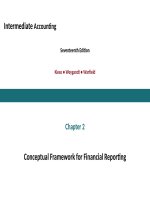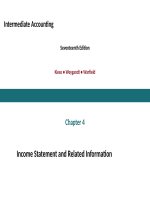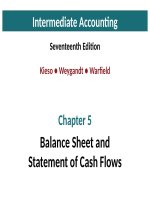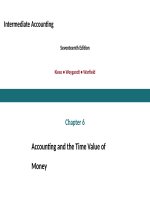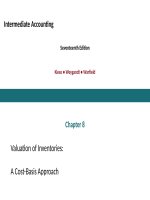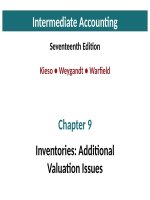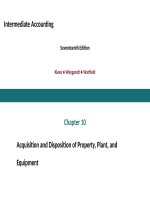Intermediate accounting 17e by kieso ch19
Bạn đang xem bản rút gọn của tài liệu. Xem và tải ngay bản đầy đủ của tài liệu tại đây (2.95 MB, 104 trang )
Intermediate Accounting
Seventeenth Edition
Kieso ● Weygandt ● Warfield
Chapter 19
Accounting for Income Taxes
This slide deck contains animations. Please disable animations if
they cause issues with your device.
Learning Objectives
After studying this chapter, you should be able to:
1. Describe the fundamentals of accounting for income
taxes.
2. Identify additional issues in accounting for income
taxes.
3. Explain the accounting for loss carryforwards.
4. Describe the presentation of deferred income taxes in
financial statements.
Copyright ©2019 John Wiley & Sons, Inc.
2
Preview of Chapter 19
Accounting for Income Taxes
Fundamentals of Accounting for Income Taxes
• Future taxable amounts and deferred taxes
• Future deductible amounts and deferred taxes
• Valuation allowance
Copyright ©2019 John Wiley & Sons, Inc.
3
Preview of Chapter 19
Accounting for Income Taxes
Additional Considerations
• Income statement presentation
• Specific differences
• Tax rate considerations
Copyright ©2019 John Wiley & Sons, Inc.
4
Preview of Chapter 19
Accounting for Income Taxes
Accounting for Net Operating Losses
• Loss carryforward
• Loss carryforward example
Copyright ©2019 John Wiley & Sons, Inc.
5
Preview of Chapter 19
Accounting for Income Taxes
Financial Statement Presentation
• Balance sheet
• Note disclosure
• Income statement
• Asset-liability method
Copyright ©2019 John Wiley & Sons, Inc.
6
Learning Objective 1
Describe the Fundamentals of
Accounting for Income Taxes
LO 1
Copyright ©2019 John Wiley & Sons, Inc.
7
Fundamentals of Accounting for
Income Taxes
Corporations must file income tax returns following the
guidelines developed by the Internal Revenue Service
(IRS).
Because GAAP and tax regulations differ in a number of
ways, the amounts reported for the following will differ:
• income tax expense (GAAP).
• income tax payable (Internal Revenue Code).
LO 1
Copyright ©2019 John Wiley & Sons, Inc.
8
Accounting for Income Taxes
LO 1
Copyright ©2019 John Wiley & Sons, Inc.
9
Accounting for Income Taxes
Illustration
Chelsea, Inc. reported revenues of $130,000 and expenses of
$60,000 in each of its first three years of operations. For tax
purposes, Chelsea reported the same expenses to the IRS in
each of the years. Chelsea reported taxable revenues of
$100,000 in 2020, $150,000 in 2021, and $140,000 in 2022.
What is the effect on the accounts of reporting different
amounts of revenue for GAAP versus tax?
LO 1
Copyright ©2019 John Wiley & Sons, Inc.
10
Book vs. Tax Differences
GAAP Reporting
2020
2021
2022
Total
Revenues
$130,000
$130,000
$130,000
$130,000
Expenses
60,000
60,000
60,000
180,000
Pretax financial income
$70,000
$70,000
$70,000
$210,000
Income tax expense (20%)
$14,000
$14,000
$14,000
$42,000
Tax Reporting
2020
2021
2022
Total
Revenues
$100,000
$150,000
$140,000
$390,000
Expenses
60,000
60,000
60,000
180,000
$40,000
$90,000
$80,000
$210,000
$8,000
$18,000
$16,000
$42,000
Taxable income
Income tax expense (40%)
LO 1
Copyright ©2019 John Wiley & Sons, Inc.
11
Book vs. Tax Differences
Comparison
Comparison of Differences
Income tax expense (GAAP)
Income tax payable (IRS)
Difference
2020
$14,000
8,000
$6,000
2021
$14,000
18,000
$(4,000)
2022
$14,000
16,000
$(2,000)
Total
$42,000
42,000
$0
Are the differences accounted for in the financial statements?
Year
2020
2021
2022
LO 1
Yes
Reporting Requirement
Deferred tax liability account increased to $6,000
Deferred tax liability account reduced by $4,000
Deferred tax liability account reduced by $2,000
Copyright ©2019 John Wiley & Sons, Inc.
12
Financial Reporting for 2020
Where does the “deferred tax liability” get reported in the financial
statements?
LO 1
Copyright ©2019 John Wiley & Sons, Inc.
13
Future Taxable and Deferred Amounts
A temporary difference is the difference between the tax basis of
an asset or liability and its reported (carrying or book) amount in
the financial statements that will result in taxable amounts or
deductible amounts in future years.
Future Taxable Amounts
Future Deductible Amounts
Deferred Tax Liability
represents the increase in
taxes payable in future years as
a result of taxable temporary
differences existing at the end
of the current year.
Deferred Tax Asset represents
the increase in taxes
refundable (or saved) in future
years as a result of deductible
temporary differences existing
at the end of the current year.
LO 1
Copyright ©2019 John Wiley & Sons, Inc.
14
Future Taxable and Deferred Amounts
Illustration
In Chelsea’s situation, the only difference between the book
basis and tax basis of the assets and liabilities relates to
accounts receivable that arose from revenue recognized for
book purposes. Chelsea reports accounts receivable at
$30,000 in the December 31, 2020, GAAP-basis balance sheet.
However, the receivables have a zero tax basis.
LO 1
Copyright ©2019 John Wiley & Sons, Inc.
15
Future Taxable and Deferred Amounts
Reversal of Temporary Difference, Chelsea Inc.
Chelsea assumes that it will collect the accounts receivable
and report the $30,000 collection as taxable revenues in
future tax returns. Chelsea does this by recording a deferred
tax liability.
LO 1
Copyright ©2019 John Wiley & Sons, Inc.
16
Future Taxable and Deferred Amounts
Deferred Tax Liability
A deferred tax liability represents the increase in taxes
payable in future years as a result of taxable temporary
differences existing at the end of the current year.
Because it is the first year of operations for Chelsea, there is
no deferred tax liability at the beginning of the year.
LO 1
Copyright ©2019 John Wiley & Sons, Inc.
17
Deferred Tax Liability 2020
Comparison of Differences
Income tax expense (GAAP)
Income tax payable (IRS)
Difference
2020
$14,000
8,000
$6,000
2021
$14,000
18,000
$(4,000)
2022
$14,000
16,000
$(2,000)
Total
$42,000
42,000
$0
Chelsea makes the following entry at the end of 2020 to
record income taxes.
Income Tax Expense
Income Taxes Payable
Deferred Tax Liability
LO 1
Copyright ©2019 John Wiley & Sons, Inc.
14,000
8,000
6,000
18
Deferred Tax Liability 2021
Comparison of Differences
Income tax expense (GAAP)
Income tax payable (IRS)
Difference
2020
$14,000
8,000
$6,000
2021
$14,000
18,000
$(4,000)
2022
$14,000
16,000
$(2,000)
Total
$42,000
42,000
$0
Chelsea makes the following entry at the end of 2021 to
record income taxes.
Income Tax Expense
Deferred Tax Liability
Income Tax Payable
LO 1
Copyright ©2019 John Wiley & Sons, Inc.
14,000
4,000
18,000
19
Deferred Tax Liability 2022
Comparison of Differences
Income tax expense (GAAP)
Income tax payable (IRS)
Difference
2020
$14,000
8,000
$6,000
2021
$14,000
18,000
$(4,000)
2022
$14,000
16,000
$(2,000)
Total
$42,000
42,000
$0
Chelsea makes the following entry at the end of 2022 to
record income taxes.
Income Tax Expense
Deferred Tax Liability
Income Tax Payable
LO 1
Copyright ©2019 John Wiley & Sons, Inc.
14,000
2,000
16,000
20
Deferred Tax Liability
Deferred Tax Liability Account after Reversals
The entry to record income taxes at the end of 2022 reduces
the Deferred Tax Liability by $2,000. The Deferred Tax Liability
account appears as follows at the end of 2022.
LO 1
Copyright ©2019 John Wiley & Sons, Inc.
21
Financial Statement Effects
Balance Sheet and Income Statement
LO 1
Copyright ©2019 John Wiley & Sons, Inc.
22
Financial Statement Effects
LO 1
Copyright ©2019 John Wiley & Sons, Inc.
23
Deferred Tax Liability
Illustration
South Carolina Corporation has one temporary difference at the
end of 2020 that will reverse and cause taxable amounts of
$55,000 in 2021, $60,000 in 2022, and $75,000 in 2023.
Starfleet’s pretax financial income for 2020 is $300,000, and the
tax rate is 30% for all years. There are no deferred taxes at the
beginning of 2020.
Instructions
a. Compute taxable income and income taxes payable for 2020.
b. Prepare the journal entry to record income tax expense,
deferred income taxes, and income taxes payable for 2020.
LO 1
Copyright ©2019 John Wiley & Sons, Inc.
24
South Carolina Corporation Example
LO 1
Copyright ©2019 John Wiley & Sons, Inc.
25
